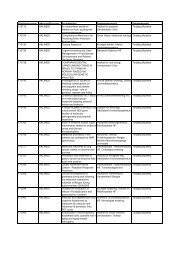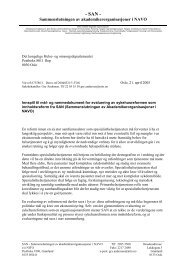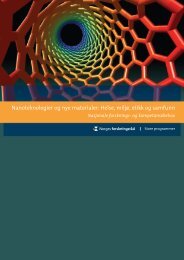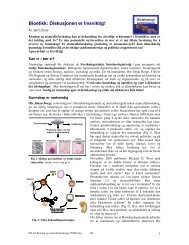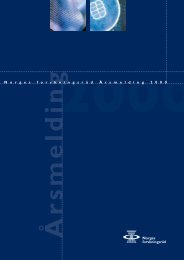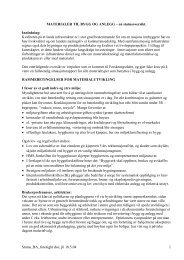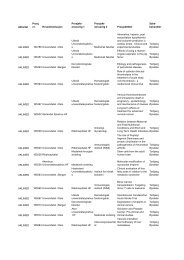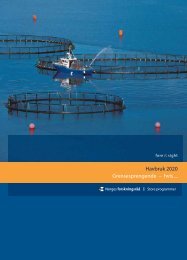A Revolution in R&D
A Revolution in R&D
A Revolution in R&D
Create successful ePaper yourself
Turn your PDF publications into a flip-book with our unique Google optimized e-Paper software.
44<br />
ogy—to discover new drugs. Broadly speak<strong>in</strong>g, the<br />
drugs that emerged were much <strong>in</strong>debted to<br />
serendipity. Research strategy consisted ma<strong>in</strong>ly of<br />
choos<strong>in</strong>g which therapeutic areas to <strong>in</strong>vestigate, and<br />
discovery efforts focused on <strong>in</strong>dividual drug targets.<br />
Development provided even fewer strategic choices:<br />
a promis<strong>in</strong>g compound emerg<strong>in</strong>g from chemistry<br />
would be tested on animals and humans <strong>in</strong> large<br />
and <strong>in</strong>efficient trials (<strong>in</strong>efficient because there was<br />
no means of identify<strong>in</strong>g <strong>in</strong> advance likely responders<br />
or nonresponders). With the rise of genomics,<br />
there have come new technologies, new approaches,<br />
new <strong>in</strong>formation, and new ways of th<strong>in</strong>k<strong>in</strong>g about<br />
INTELLECTUAL PROPERTY—LOST AND FOUND<br />
Gene patent applications are flourish<strong>in</strong>g: <strong>in</strong> 2000<br />
alone, more than 20,000 were submitted to the<br />
United States Patent and Trademark Office. Despite<br />
the large number of applications, two central questions<br />
have yet to be answered. What exactly can be<br />
patented? And what rights does a patent actually<br />
confer on its holder?<br />
For a gene or gene fragment (an expressed sequence<br />
tag, or EST) to secure a patent, its “utility” has to be<br />
established. In January 2001, the United States<br />
Patent and Trademark Office issued Utility Exam<strong>in</strong>ation<br />
Guidel<strong>in</strong>es to clarify the standard used. (That<br />
<strong>in</strong> itself was encourag<strong>in</strong>g to those <strong>in</strong> favor of gene<br />
patent<strong>in</strong>g, re<strong>in</strong>forc<strong>in</strong>g the view that genetic material<br />
can <strong>in</strong>deed be patented.) Follow<strong>in</strong>g on the <strong>in</strong>terim<br />
guidel<strong>in</strong>es released <strong>in</strong> 1999, the new guidel<strong>in</strong>es<br />
advise patent seekers to provide at least one “specific,<br />
substantial, and credible” use for the gene or<br />
gene fragment <strong>in</strong> question. This restatement effectively<br />
fixes the height of the hurdle for applicants<br />
and disqualifies undersubstantiated applications<br />
from the outset. Some uncerta<strong>in</strong>ty rema<strong>in</strong>s, however:<br />
whether it is necessary when present<strong>in</strong>g evidence<br />
of utility to understand the actual biological<br />
function of the genetic material, and whether gene<br />
research and development. These have brought<br />
with them a new opportunity, or imperative, to turn<br />
research to competitive advantage.<br />
So companies now have weighty strategic issues to<br />
address. At the corporate level, the question is how<br />
much to <strong>in</strong>vest, given the current environment. For<br />
R&D leadership, the question tends to be where to<br />
focus those <strong>in</strong>vestments—<strong>in</strong> what therapy areas, on<br />
what target classes, and so on—as well as which<br />
technologies to adopt and how to adopt them (<strong>in</strong>house<br />
or externally, for example), and how to mitigate<br />
the associated risks.<br />
fragments, as dist<strong>in</strong>ct from full-length genes, are eligible<br />
for a patent.<br />
If gett<strong>in</strong>g a patent approved seems daunt<strong>in</strong>g, all the<br />
more so is enforc<strong>in</strong>g it, or shelter<strong>in</strong>g confidently <strong>in</strong><br />
its protective embrace. The strength of protection<br />
afforded by a gene patent is still a develop<strong>in</strong>g legal<br />
issue. One recent court decision, though, clearly<br />
marks a setback for patent holders—Festo Corp. v<br />
Shoketsu K<strong>in</strong>zoku Kogyo Kabushiki, decided by the<br />
federal circuit court <strong>in</strong> November 2000. It appears<br />
to weaken many patents by preclud<strong>in</strong>g a broad <strong>in</strong>terpretation<br />
of most patent claims; it does so by virtually<br />
exclud<strong>in</strong>g the “doctr<strong>in</strong>e of equivalents.” This is a<br />
doctr<strong>in</strong>e that generally allows extension of a patent’s<br />
claim beyond its literal language, so that a would-be<br />
<strong>in</strong>fr<strong>in</strong>ger who makes trivial changes to the patented<br />
product is not thereby exempt from the patent’s constra<strong>in</strong>ts.<br />
Accord<strong>in</strong>g to the Festo rul<strong>in</strong>g, if the language<br />
of the legal claim diverges from that of the<br />
patent itself, the doctr<strong>in</strong>e no longer applies. Many<br />
patents now look very narrow and vulnerable, and<br />
companies will have to plan their patent submissions<br />
even more carefully <strong>in</strong> the future. Or hope for<br />
a change of fortune: the U.S. Supreme Court is<br />
expected to review Festo <strong>in</strong> the 2001–2002 term.



